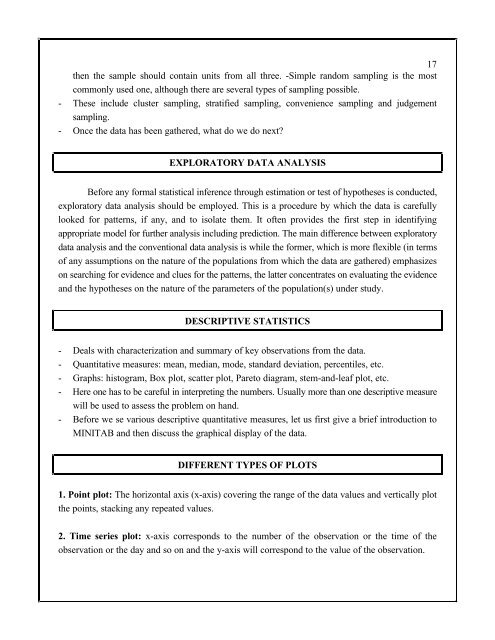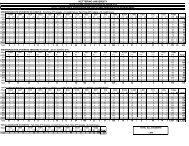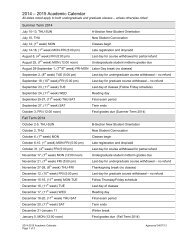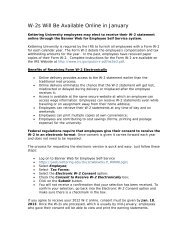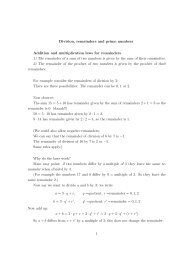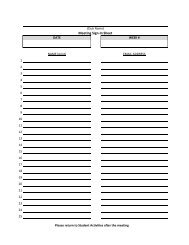1 CLASS LECTURE NOTES - What is Applied Statistics ...
1 CLASS LECTURE NOTES - What is Applied Statistics ...
1 CLASS LECTURE NOTES - What is Applied Statistics ...
You also want an ePaper? Increase the reach of your titles
YUMPU automatically turns print PDFs into web optimized ePapers that Google loves.
17<br />
then the sample should contain units from all three. -Simple random sampling <strong>is</strong> the most<br />
commonly used one, although there are several types of sampling possible.<br />
- These include cluster sampling, stratified sampling, convenience sampling and judgement<br />
sampling.<br />
- Once the data has been gathered, what do we do next?<br />
EXPLORATORY DATA ANALYSIS<br />
Before any formal stat<strong>is</strong>tical inference through estimation or test of hypotheses <strong>is</strong> conducted,<br />
exploratory data analys<strong>is</strong> should be employed. Th<strong>is</strong> <strong>is</strong> a procedure by which the data <strong>is</strong> carefully<br />
looked for patterns, if any, and to <strong>is</strong>olate them. It often provides the first step in identifying<br />
appropriate model for further analys<strong>is</strong> including prediction. The main difference between exploratory<br />
data analys<strong>is</strong> and the conventional data analys<strong>is</strong> <strong>is</strong> while the former, which <strong>is</strong> more flexible (in terms<br />
of any assumptions on the nature of the populations from which the data are gathered) emphasizes<br />
on searching for evidence and clues for the patterns, the latter concentrates on evaluating the evidence<br />
and the hypotheses on the nature of the parameters of the population(s) under study.<br />
DESCRIPTIVE STATISTICS<br />
- Deals with characterization and summary of key observations from the data.<br />
- Quantitative measures: mean, median, mode, standard deviation, percentiles, etc.<br />
- Graphs: h<strong>is</strong>togram, Box plot, scatter plot, Pareto diagram, stem-and-leaf plot, etc.<br />
- Here one has to be careful in interpreting the numbers. Usually more than one descriptive measure<br />
will be used to assess the problem on hand.<br />
- Before we se various descriptive quantitative measures, let us first give a brief introduction to<br />
MINITAB and then d<strong>is</strong>cuss the graphical d<strong>is</strong>play of the data.<br />
DIFFERENT TYPES OF PLOTS<br />
1. Point plot: The horizontal ax<strong>is</strong> (x-ax<strong>is</strong>) covering the range of the data values and vertically plot<br />
the points, stacking any repeated values.<br />
2. Time series plot: x-ax<strong>is</strong> corresponds to the number of the observation or the time of the<br />
observation or the day and so on and the y-ax<strong>is</strong> will correspond to the value of the observation.


